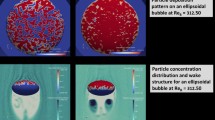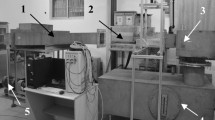Abstract—
In this study, the interaction between a spherical solid particle descending in a fine-bubble plume and the fine-bubbles around the particle is investigated experimentally. The fine-bubbles, which are formed by water electrolysis and have an average diameter of 0.037 mm, rise via buoyancy to form bubble plumes. The average bubble velocity in the conduit is 0.05 mm/s. A spherical solid particle with a diameter of 11.1 mm and a density of 1130 kg/m3 is dropped into the fully-developed bubble plume. The particle falls in a meandering motion in the fine-bubble plume. In this process, the terminal velocity of the particles falling in the fine-bubble plume is almost identical to that of a particle falling in the quiescent water. Additionally, after the fine-bubbles have been separated from the particle surface, they flow into the wake of the particle, forming a stagnant region. The particle wake diameter increases threefold, as compared with its value in the downstream direction of the fine-bubble plume.







Similar content being viewed by others

REFERENCES
G. Q. Yang, B. Du, and L-S. Fan, “Bubble formation and dynamics in gas-liquid-solid fluidization–A review,” Chem. Eng. Sci. 62, 2–27 (2007).
W-J. Lu, S-J. Hwang, and C.M. Chang, “Liquid velocity and gas holdup in three-phase internal loop airlift reactors with low-density particles,” Chem. Eng. Sci. 50(8), 1301–1310 (1995).
K. Tsuchiya, A. Furumoto, L-S. Fan, and J. Zhang, “Suspension viscosity and bubble rise velocity in liquid-solid fluidized beds,” Chem. Eng. Sci. 52(18), 3053–3066 (1997).
K. Tsuchiya and A. Furumoto, “Tortuosity of bubble rise path in a liquid-solid fluidized bed: Effect of particle shape,” AIChE J. 41(6), 1368–1374 (1995).
A. B. Pandit and J. B. Joshi, “Effect of physical properties on the suspensionof solid particles in three-phase sparged reactors, " Int. J. Multiphase Flow 13(3), 415–427 (1987).
C. David and L-S. Fan, “Solid-liquid mass transfer in a gas-liquid fluidized bed,” Chem. Eng. Sci. 41, 107 (1986).
T. Yoshinaga and Y. Sato, “Performance of an air-lift pump for conveying coarse particles,” Int. J. Multiphase Flow 22(2), 223–238 (1996).
H. Fujimoto, S. Ogawa, H. Takuda, and N. Hatta, “Operation performance of a small air-lift pump for conveying solid particles,” Trans. ASME, J. Energy Resources Tech. 125(1), 17–25 (2003).
S. Z. Kassab, H. A. Kandil, H. A. Warda, and W. H. Ahmed, “Experimental and analytical investigations of airlift pumps operating in three-phase flow,” Chem. Eng. Sci. 131(1–3), 273–281 (2007).
Y. Zhang, F. Chen, Y. Zhang, and X. Du, “Experimental investigations of interactions between a laser-induced cavitation bubble and a spherical particle,” Exp. Therm. Fluid Sci. 98, 645–661 (2018).
Y. Zhang, X. Xie, Y. Zhang, and X. Du, “Experimental study of influences of a particle on the collapsing dynamics of a laser-induced cavitation bubble near a solid wall,” Exp. Therm. Fluid Sci. 105, 289–306 (2019).
M. W. Baltussen, L. J. H. Seelen, J. A. M. Kuipers, and N. G. Deen, “Direct numerical simulation of gas-liquid-solid three phase flows,” Chem. Eng. Sci. 100, 293–299 (2013).
Y. Li, J. Zhang, and L-S. Fan, “Numerical simulation of gas-liquid-solid fluidization systems using a combined CFD-VOF-DPM method: Bubble wake behavior,” Chem. Eng. Sci. 54(21), 5101–5107 (1999).
O. A. Abramov, S. I. Akhatov, N. A. Gumerov, Y. A. Pityuk, and S. P. Sametov, “Unsteady rise of a bubble in a viscous fluid at small Reynolds numbers”, Fluid Dynamics 53(3), 337–346 (2018).
A. S. Kozelkov, A. A. Kurkin, V. V. Kurulin, S. V. Lashkin, N. V. Tarasova, and E. S. Tyatyushkina, “Numerical modeling of the free rise of an air bubble,” Fluid Dynamics 51(6), 709–721 (2016).
M. A. Vorobyev, O. N. Kashinsky, and V. V. Randin, “Downward bubbly flow in a pipe at subcritical Reynolds numbers,” Fluid Dynamics 54(2), 264–269 (2019).
V. A. Arkhipov, I. M. Vasenin, A. S. Tkachenko, and A. S. Usanina, “Unsteady rise of a bubble in a viscous fluid at small Reynolds numbers,” Fluid Dynamics 50(1), 79–86 (2015).
J. Rodríguez-Rodríguez, A. Sevilla, C. Martínez-Bazán, and J. M. Gordillo, “Generation of fine-bubbles with applications to industry and medicine,” Annual Review of Fluid Mech. 47, 405–429 (2015).
A. Rahman, A. K. Darban, A. Mahmoud, and F. Maoming, “Nano-fine-bubble flotation of fine and ultrafine chalcopyrite particles,” Int. J. Mining Sci. Technol. 24(4), 559–566 (2014).
T. Temesgen, T. T. Bui, M. Han, T. Kim, and H. Park, “Fine- and nanobubble technologies as a new horizon for water-treatment techniques: A review,” Adv. Colloid and Interface Sci. 246, 40–51 (2017).
K. Terasaka, S. Aoki, and D. Kobayashi, “Recovery of fine iron oxide particulates from waste water using fine-bubble flotation,” in: Proc. 19th Int. Symp. Transport Phenomena, Reykjavik, August 17—21, 2008 (2008).
T. Uchiyama, Y. Kawasaki, T. Degawa, and K. Takamure, “Motion of a spherical particle in a fine-bubble plume and the behavior of fine-bubbles around the particle,” J. Mech. Eng. Sci., IMechE. 234(7), 1340–1350 (2020).
C. Mimeau, G.-H. Cottet, and I. Mortazavi, “Direct numerical simulation of three-dimensional flows past obstacles with a vortex penalization method,” Computers Fluids, 136, 331 (2016).
R. L. C. Flemmer and C. L. Banks, “On the drag coefficient of a sphere,” Powder Technol. 48(3), 217–221 (1986).
Z. L. Arsenijević, Z. B. Grbavčić, R. V. Garić-Grulović, and N. M. Bošković-Vragolović, “Wall effects on the velocities of a single sphere settling in a stagnant and counter-current fluid and rising in a co-current fluid,” Powder Technol. 203(2), 237–242 (2010).
R. Turton and A. Levenspiel, “A short note on the drag correlation for spheres,” Powder Technol. 47(1), 83–86 (1986).
B. R. Clayton and B. S. Massey, “Flow visualization in water: a review of techniques,” J. Sci. Instrum. 44(1), 2–11 (1967).
Author information
Authors and Affiliations
Corresponding author
Ethics declarations
The Authors declare no potential conflicts of interest with respect to the research, authorship, and/or publication of this article.
Rights and permissions
About this article
Cite this article
Takamure, K., Kawasaki, Y., Degawa, T. et al. Falling of a Spherical Particle in Fine-Bubble Plume and Fine-Bubble Behavior around the Particle. Fluid Dyn 56, 612–621 (2021). https://doi.org/10.1134/S001546282105013X
Received:
Revised:
Accepted:
Published:
Issue Date:
DOI: https://doi.org/10.1134/S001546282105013X



